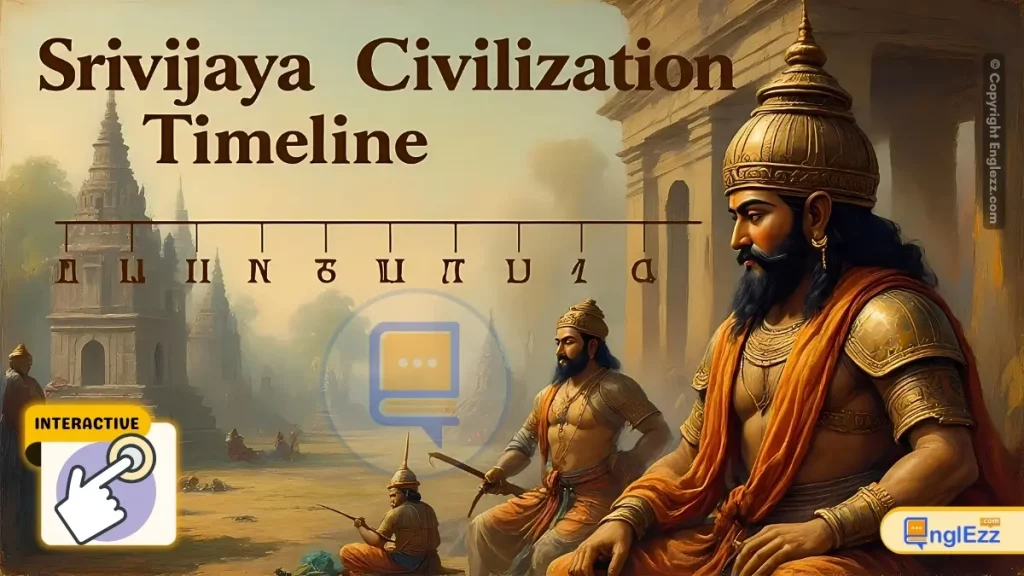
The Story of Srivijaya Empire
The Maritime Power of Southeast Asia (650-1377 CE)
Introduction
The Srivijaya Journey
The Srivijaya Empire was a dominant thalassocratic (maritime) city-state based on the island of Sumatra, Indonesia, which influenced much of Southeast Asia from the 7th to the 13th century. Srivijaya was an important center for the expansion of Buddhism from the 8th to the 12th century and established trade links not only with the states in the Malay Archipelago but also with China and India.
Srivijaya’s wealth and power came from its strategic location along the busy maritime trade routes between China and India, as well as its control over regional trade. The empire was a center for Buddhist learning and attracted scholars from as far away as China. The Srivijayan navy controlled the Strait of Malacca and other key shipping lanes, exacting tolls and protecting merchant ships from pirates.
Early Period
The early period (650-850 CE) saw the rise of Srivijaya as a maritime power based in Palembang, Sumatra. During this time, Srivijaya established control over the strategic Strait of Malacca and began developing its distinctive blend of indigenous Malay culture with Indian influences, particularly in religion (Buddhism) and political organization.
Peak Period
The peak period (850-1025 CE) was the golden age of Srivijaya, marked by extensive trade networks, cultural influence, and Buddhist scholarship. During this time, Srivijaya controlled much of maritime Southeast Asia and established diplomatic relations with China’s Tang and Song dynasties. The empire became a major center of Buddhist learning, attracting scholars from across Asia.
Modern Rediscovery
After centuries of obscurity, the Srivijaya Empire was rediscovered in the early 20th century through Chinese historical records and archaeological findings. Modern research has revealed the sophistication of Srivijaya’s maritime network and its crucial role in the spread of Buddhism and cultural exchange across Southeast Asia.
Interactive Srivijaya Empire Timeline
Chinese Monk Yijing’s Visit
Chinese Buddhist monk Yijing visits Srivijaya on his way to India, providing the first detailed account of the kingdom.
Read moreIn 671 CE, the Chinese Buddhist monk Yijing (I-ching) stopped at Srivijaya’s capital at Palembang for six months to study Sanskrit grammar before continuing his journey to India. His writings provide the earliest detailed account of Srivijaya, describing it as an important center for Buddhist learning where over a thousand monks studied.
Key observations from Yijing’s account:
- Srivijaya was already a significant Buddhist center with extensive monastic facilities
- The kingdom controlled strategic sea routes
- It served as a stopping point for pilgrims traveling between China and India
- The local culture blended indigenous Malay traditions with Indian influences
Yijing’s records are crucial for understanding early Srivijaya, as few other contemporary sources exist. He would return to Srivijaya in 685 CE and spend several years translating Buddhist texts there before returning to China.
Further Reading
- Wolters, O.W. Early Indonesian Commerce (1967)
- Takakusu, J. A Record of the Buddhist Religion as Practised in India and the Malay Archipelago (1896)
Kedukan Bukit Inscription
The oldest known inscription mentioning Srivijaya is carved, marking the empire’s expansion under Dapunta Hyang.
Read moreThe Kedukan Bukit inscription, dated 682 CE, is the oldest known written record mentioning Srivijaya. Discovered near Palembang, it records the victorious journey of Dapunta Hyang (a Srivijayan ruler or military leader) who led an expedition that expanded Srivijaya’s territory.
Key information from the inscription:
- Written in Old Malay using the Pallava script (derived from southern India)
- Describes a military expedition with 20,000 troops by land and 1,312 by boat
- Mentions the establishment of a settlement called “Minanga”
- Provides evidence of early Srivijayan state organization and military capability
The inscription demonstrates that by the late 7th century, Srivijaya had developed sufficient administrative organization to mount large-scale military expeditions and had adopted Indian cultural elements like writing while maintaining distinct Malay characteristics.
Further Reading
- Coedès, George. The Indianized States of Southeast Asia (1968)
- Miksic, John N. Ancient Southeast Asia (2017)
Golden Age Begins
Srivijaya enters its golden age as a major maritime power and center of Buddhist learning.
Read moreBy 850 CE, Srivijaya had established itself as the dominant maritime power in Southeast Asia, controlling key trade routes through the Strait of Malacca and the Sunda Strait. The empire’s golden age was characterized by:
- Extensive trade networks connecting China, India, and the Middle East
- Establishment of tributary relations with China’s Tang Dynasty
- Development of major Buddhist centers attracting scholars from across Asia
- Construction of impressive architectural works, including temples and monasteries
During this period, Srivijaya’s influence extended across much of Sumatra, the Malay Peninsula, and western Java. The empire’s wealth came from its control of trade in luxury goods like spices, aromatic woods, and resins, as well as its role as an entrepôt where goods were stored and transshipped.
Further Reading
- Hall, Kenneth R. Maritime Trade and State Development in Early Southeast Asia (1985)
- Manguin, Pierre-Yves. “Srivijaya: Trade and Connectivity in the Pre-Modern Malay World” (2011)
Zabag Kingdom Described
Arab merchant Abu Zaid Hasan describes Srivijaya (referred to as Zabag) as exceptionally wealthy.
Read moreIn 904 CE, Arab merchant and geographer Abu Zaid Hasan recorded descriptions of Srivijaya (which Arabs called Zabag) as an exceptionally wealthy kingdom. His accounts provide valuable external perspectives on Srivijaya at its height.
Key observations from Abu Zaid’s account:
- Described Srivijaya as having “territories on both shores of the sea” (likely Sumatra and the Malay Peninsula)
- Noted the kingdom’s wealth came from trade in spices, aromatics, and other luxury goods
- Mentioned the Srivijayan king’s control over neighboring islands
- Recorded that the king possessed more gold than any other ruler
These Arab accounts confirm Srivijaya’s reputation as a wealthy trading empire and its integration into the broader Indian Ocean trade network that connected East Asia with the Middle East and beyond.
Further Reading
- Tibbetts, G.R. A Study of the Arabic Texts Containing Material on South-East Asia (1979)
- Wade, Geoff. “Srivijaya and the China Connection” (2009)
Chola Invasion
The Chola Empire from South India launches a devastating naval raid on Srivijaya.
Read moreIn 1025 CE, the Chola emperor Rajendra I launched a massive naval expedition against Srivijaya, marking the beginning of the empire’s decline. The Chola forces attacked and captured several Srivijayan ports including Palembang, Jambi, and Kedah.
Key aspects of the Chola invasion:
- Motivated by Srivijaya’s interference with Chola trade missions to China
- Demonstrated the vulnerability of Srivijaya’s dispersed maritime empire
- Resulted in the temporary occupation of key Srivijayan ports
- Weakened Srivijaya’s control over the Strait of Malacca
While Srivijaya recovered politically from the invasion, its economic dominance was permanently weakened. The Chola raid opened the way for other regional powers to challenge Srivijaya’s control over maritime trade routes.
Further Reading
- Kulke, Hermann. “The Naval Expeditions of the Cholas in the Context of Asian History” (2009)
- Sastri, K.A. Nilakanta. The Cholas (1955)
Singhasari Expedition
The Javanese kingdom of Singhasari launches a punitive expedition against Srivijaya.
In 1288 CE, the East Javanese kingdom of Singhasari under King Kertanegara launched a naval expedition against Srivijaya, further weakening the already declining empire. This event is recorded in the Javanese Nagarakretagama poem and Chinese sources.
Key details about the Singhasari expedition:
- Motivated by Srivijaya’s attempts to reassert control over the Strait of Malacca
- Resulted in the capture of the Srivijayan capital at Palembang
- Marked the growing power of Javanese kingdoms in maritime Southeast Asia
- Accelerated the shift of regional power from Sumatra to Java
Following this expedition, Srivijaya became increasingly fragmented, with regional centers like Jambi and Malayu asserting greater autonomy. The empire’s control over trade routes continued to diminish as new powers emerged in the region.
Further Reading
- Berg, C.C. “The Javanese Picture of the Past” (1975)
- Miksic, John N. Singapore and the Silk Road of the Sea, 1300-1800 (2013)
Rediscovery by Historians
French scholar George Coedès identifies Srivijaya as a major historical empire based on Chinese sources.
Read moreIn 1918, French historian George Coedès published his identification of “Srivijaya” as the empire referred to in Chinese records as Sanfoqi. This marked the modern rediscovery of Srivijaya as a significant historical entity, as knowledge of the empire had been lost for centuries.
Key aspects of Coedès’ work:
- Correlated Chinese, Arab, and Southeast Asian sources to reconstruct Srivijaya’s history
- Identified Palembang as the likely center of the empire
- Recognized Srivijaya’s role as a major maritime power and Buddhist center
- Established the basic chronology of Srivijaya’s rise and fall
Coedès’ work sparked renewed interest in Srivijaya and led to archaeological investigations that have continued to uncover the empire’s remains. His research fundamentally changed understanding of Southeast Asian history by revealing the importance of early maritime kingdoms.
Further Reading
- Coedès, George. The Indianized States of Southeast Asia (1968)
- Wolters, O.W. Early Indonesian Commerce and the Rise of Srivijaya (1967)
Underwater Archaeology
Maritime archaeological discoveries reveal Srivijaya’s extensive trade networks.
Read moreBeginning in the 1980s, underwater archaeological discoveries provided dramatic new evidence of Srivijaya’s maritime trade networks. Shipwrecks like the Belitung wreck (discovered 1998) and the Intan wreck (discovered 1997) contained cargoes that demonstrated the extent of Srivijaya’s commercial connections.
Key findings from maritime archaeology:
- Chinese ceramics and Middle Eastern glassware in Srivijayan waters
- Evidence of sophisticated shipbuilding techniques
- Discovery of trade goods matching descriptions in Chinese and Arab texts
- Confirmation of Srivijaya’s role as an entrepôt where goods were transshipped
These discoveries have transformed understanding of Srivijaya’s economic importance and the scale of Indian Ocean trade during its peak. They provide tangible evidence of the luxury goods that made the empire wealthy and the technological capabilities that allowed it to dominate regional trade routes.
Further Reading
- Flecker, Michael. “The Archaeological Excavation of the 10th Century Intan Shipwreck” (2002)
- Manguin, Pierre-Yves. “Southeast Asian Shipping in the Indian Ocean During the 1st Millennium AD” (2010)
Srivijaya Empire Quiz
Test Your Knowledge of Srivijaya History
Frequently Asked Questions
Common Questions About Srivijaya Empire
Srivijaya’s power came from several key factors:
- Strategic location: It controlled the Strait of Malacca, the main shipping route between China and India
- Naval dominance: Its powerful navy could protect trade ships and enforce tolls
- Trade monopoly: It served as an entrepôt where goods were stored and exchanged
- Diplomatic relations: It maintained good relations with both China and Indian states
- Cultural influence: As a center of Buddhist learning, it attracted scholars and pilgrims
By controlling the choke points of maritime trade and offering protection and services to merchants, Srivijaya became indispensable to the functioning of Asian trade networks.
Srivijaya’s decline resulted from multiple factors:
- External attacks: The Chola raid in 1025 and later Javanese expeditions weakened its control
- Economic changes: New trade routes and ports emerged, bypassing Srivijaya
- Political fragmentation: Vassal states and regional centers became more independent
- Environmental factors: Possible siltation of its riverine capital at Palembang
- Rise of competitors: New powers like the Javanese kingdoms and later Melaka challenged its dominance
The decline was gradual, taking several centuries, as Srivijaya lost its monopoly over regional trade routes and its political influence waned.
Srivijaya maintained extensive diplomatic and trade relations with China:
- Tributary missions: Sent regular embassies to Chinese courts bearing gifts
- Trade privileges: Received favorable treatment in Chinese ports
- Cultural exchange: Chinese monks studied at Srivijayan Buddhist centers
- Political recognition: Chinese sources refer to Srivijaya as a major power
- Protection: Sometimes sought Chinese support against rivals
These relations were crucial for Srivijaya’s commercial success, as China was the largest market for Southeast Asian trade goods. The Tang and Song dynasties viewed Srivijaya as an important partner in maintaining maritime trade routes.
Several factors contributed to Srivijaya being forgotten until modern times:
- Perishable materials: Most Srivijayan structures were built of wood and brick rather than durable stone
- Geographical changes: Rivers shifted and coastlines changed, burying remains
- Lack of local records: Few indigenous written sources survived the tropical climate
- Focus on later empires: Historians paid more attention to the Majapahit and Melaka sultanate
- Colonial perspectives: European scholars initially underestimated pre-colonial Southeast Asian achievements
It was only through careful study of Chinese, Arab, and limited local sources that historians like George Coedès could reconstruct Srivijaya’s importance in the early 20th century.
Conclusion
The Srivijaya Legacy
The Srivijaya Empire represents one of the most sophisticated maritime powers in Southeast Asian history. From its strategic base in Sumatra, Srivijaya dominated regional trade routes for centuries, facilitated cultural exchange between India and China, and helped spread Buddhism throughout the Malay Archipelago.
While Srivijaya eventually declined, its legacy lived on in the trade networks, cultural patterns, and political models of later Southeast Asian states. The empire demonstrated how maritime connectivity could create wealth and power in the pre-modern world, a lesson that would be followed by successor states like Melaka.
Srivijaya Empire Key Takeaways
Early Foundations
The early period saw Srivijaya emerge as a maritime power controlling the strategic Strait of Malacca and developing a unique blend of Malay and Indian cultural elements.
Peak Achievements
At its height, Srivijaya controlled extensive trade networks, was a center of Buddhist learning, and maintained diplomatic relations across Asia.
Gradual Decline
Attacks from the Cholas and Javanese kingdoms, combined with changing trade patterns, led to Srivijaya’s gradual loss of power over several centuries.
Modern Rediscovery
20th century scholarship and archaeological discoveries revealed Srivijaya’s importance in Southeast Asian history after centuries of obscurity.
The study of Srivijaya reminds us of the crucial role maritime networks played in connecting civilizations long before the modern era. As archaeological research continues, we gain new insights into this remarkable empire that once dominated the sea lanes of Southeast Asia and facilitated the flow of goods, ideas, and people across the ancient world.
Recommended Reading About Srivijaya Empire
- Coedès, George. The Indianized States of Southeast Asia (1968)
- Wolters, O.W. Early Indonesian Commerce and the Rise of Srivijaya (1967)
- Hall, Kenneth R. Maritime Trade and State Development in Early Southeast Asia (1985)
- Manguin, Pierre-Yves. “Srivijaya: Trade and Connectivity in the Pre-Modern Malay World” (2011)
- Miksic, John N. Ancient Southeast Asia (2017)









